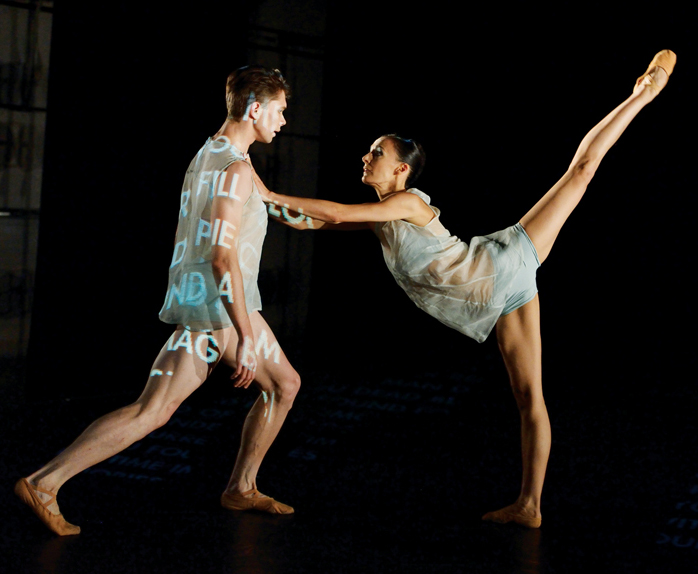Stuttgart Ballet: Gala / Onegin / Skizzen - Vancouver Ballet Society
- Home
- Reviews 2014 - 2019
- Stuttgart Ballet: Gala / Onegin / Skizzen

by Gary Smith
When Stuttgart Ballet gives a party, it’s a big one. Celebrating Vancouver-born Reid Anderson’s 20 seasons as artistic director involved a week of international guest artists joining stars of Stuttgart Ballet and students of the German company’s affiliated John Cranko School, along with more sparkle dust and cascading balloons than you could imagine.
At the final gala night, besides a packed Stuttgart Opera House, there were several thousand people watching on a huge outdoor screen in the Schlossgarten. At the end of the evening, a banner celebrating Anderson’s tenure descended onstage. Hundreds of balloons and silver streamers fell. Pieces of gold paper swirled in the air like a blizzard of doubloons. Flowers rained down from the upper side boxes of the theatre.
All this happened after a surprise finale that had the Stuttgart dancers strutting in silver costumes, raising top hats, singing and dancing One from A Chorus Line. “It was hard to keep the finale a secret,” Tamas Detrich, Anderson’s second-in-command and successor in two years says. “We had to hide everything every time Reid wandered into the theatre.” Rewritten with words that celebrated Anderson’s large-scale effect on the company since taking over the directorship in 1996, the Broadway-styled number brought the house down.
Anderson, looking trim and handsome at 67, has had an amazing career as both a Stuttgart dancer and head of the company. In the early years, his performances in the title role of John Cranko’s Onegin, as well as in many other important ballets, sealed his reputation as a rare dramatic dancer. But it is his leadership, offering tough love and inspiration to his dancers, that has made him special.
There was a feeling of family in the theatre that July night, with the company’s dancers, guest artists and audience radiating affection. The program, fashioned by Detrich, was superbly balanced with contemporary and classical pieces; five hours of eye-popping dance, opening with students of the Cranko School dancing Études, in a lovely adaptation of the Harald Lander ballet. The piece built as the older students flew across the stage in elegant jetés and then paused in traditional ballet poses. This gave way to a Grand Défilé, choreographed by Detrich, which celebrated the strength and beauty of this classical company.
Detrich’s staging of the gala often paired guest artists with Stuttgart stars. For instance, Semyon Chudin from the Bolshoi Ballet partnered Stuttgart’s Anna Osadcenko in a thrilling Sleeping Beauty pas de deux. Chudin’s elegant leaps and soft-as-down landings matched Osadcenko’s feathery turns and rapid-fire fouettés. And Mathieu Ganio from Paris Opera Ballet created just the kind of dance drama expected from John Neumeier’s Die Kameliendame, matching Stuttgart Ballet’s exquisite Alicia Amatriain heartbeat for heartbeat.
Stuttgart Ballet’s Friedemann Vogel, one of the most passionate and elegant male dancers on the international scene, thrilled in Tchaikovsky Pas de Deux, partnering Elisa Badenes, rising Stuttgart star, in this Balanchine bonanza of dance demanding technical precision, speed and musicality. Badenes also dazzled in the Black Swan pas de deux from Swan Lake, partnered by new talent Constantine Allen.
There was a surprise return to the stage by former Stuttgart dancer, and present-day costume designer, Thomas Lempertz in Marco Goecke’s contemporary Greyhounds. Lempertz was a revelation, displaying all the requisite technique and passion necessary to make this quirky solo work.
Other highlights were John Neumeier’s lush and romantic choreography for Liliom, featuring Hélène Bouchet and Carsten Jung of Hamburg Ballet, and Elisa Carrillo Cabrera and Mikhail Kaniskin from Berlin Ballet dancing Nacho Duato’s inventive Forms of Silence and Emptiness to music by Bach.
Of course, there were the inevitable speeches by politicians, but these were kept mercifully short. One surprise announcement was that Detrich and Anderson had been made official German citizens. Detrich, born in the United States, and Anderson, in Canada, will also retain their original citizenships.
“I don’t know how they ever managed it, as you are not allowed to become a German and retain dual citizenship. Wheels within wheels, I guess,” Anderson said at intermission.
Earlier in the week, farewells were also said to Sue Jin Kang, who danced her final Stuttgart performance, giving an emotionally devastating account of Tatiana in Cranko’s Onegin, partnered by an attentive Jason Reilly. Kang, who now heads Korean National Ballet, proved the strength of her impeccable dance technique and the enduring heart of her response to passionate characterization.
Another highlight of the special Stuttgart season was an evening titled Skizzen (Scenes), which paid tribute to the many ballets created during Anderson’s tenure with the company. Excerpts from works such as Marco Goecke’s Orlando, danced by Vogel, and Christian Spuck’s Lulu, with Amatriain, reminded us of the richness of the Stuttgart repertoire, enhanced superbly since Anderson took over as intendent.
What a tribute. What a week of dance.
DI WINTER 2016

Photo: Stuttgart Ballet
